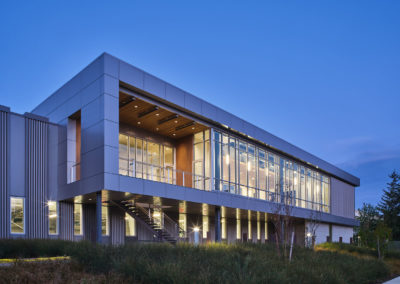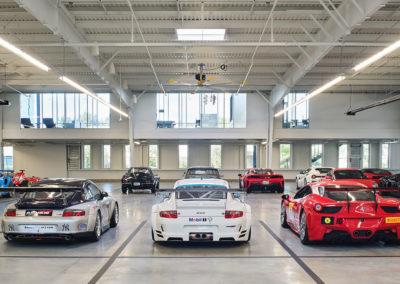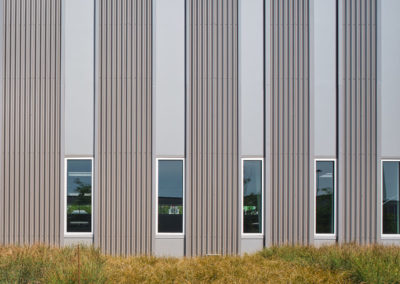Driver’s Club
“We wanted the space to be beautiful for members’ cars,” says Wybenga, “but it also needed to be efficiently laid out. This building is designed so that everything from the joints in the pavement and the major steel frame elements are all on a module derived from the width of the parking stalls. PEMBs are really well-suited to this kind of thinking. I think the modularity was something that worked well for us.”
Details
| Location | Redmond, WA |
| Size | 66,235 sf |
| Completed | February 2019 |
| Categories | Recreational, Commercial |
METAL CONSTRUCTION NEWS; December 02, 2019; By Paul Deffenbaugh (Full Article)
An Enthusiastic Design
There are certain hobbies that attract people who devote themselves to the hobby with a devotion beyond mere interest. Among those types of people are high-performance car enthusiasts. They blur the lane line between vocation and avocation.
For such enthusiasts, a facility needs to deliver more than just mundane storage capabilities, and the Drivers Club, Redmond, Wash., is a clubhouse that provides storage, of course, but also a showroom, and a true clubhouse where members can gather for social activities.
Get the Right Team
SPAN came into the process early and the design/ construction team considered coordinating the construction of the Costco down the street with the Drivers Club building for efficiency’s sake, but scheduling prevented that.
SPAN is a Butler Builder, which brought that company into the picture, and Wybenga speaks highly of the expertise and devotion SPAN brought to the project, especially through the efforts of project manager Roger Acres. “Roger was an unbelievably great teammate and was instrumental to this project being executed to a high level as a pre-engineered building. He got it from the very beginning. Rather than consistently telling me things like ‘that’s not the way we do that’ in standard PEMBs, he’d work with us to find ways to utilize the inherent properties of how they work and how these things are put together to help us get what we were after and keep the project on budget.”
Why PEMB
Tim Wybenga, principal, TVA Architects, had worked with the owner for quite awhile, and after they found the site, by coincidence a Costco building was being built down the street. That introduced both the idea for a pre-engineered metal building and Span Construction & Engineering Inc., Madera, Calif., which was erecting the building and is also the largest metal building contractor in the country.
“We wanted the space to be beautiful for members’ cars,” says Wybenga, “but it also needed to be efficiently laid out. This building is designed so that everything from the joints in the pavement and the major steel frame elements are all on a module derived from the width of the parking stalls. PEMBs are really well-suited to this kind of thinking. I think the modularity was something that worked well for us.”
The project comprises two buildings, one a storage facility with automated mechanized stackers, and the other a showroom and clubhouse. The idea behind the showroom is to make it appear almost like an art gallery with the cars on display for the members who congregate in a raised clubhouse that has large windows overlooking the gallery.
The overlooking gallery feels a bit like a viewing stand on a racetrack, but its purpose is more practical. “Getting the members up high allows them to see the cars as a collective in a way that you can’t from the ground,” says Wybenga. “It also changes the space from feeling like the waiting room at an industrial manufacturing building or an auto shop to something that’s literally and perceptually elevated.”
The Panels Make a Statement
The use of metal panels on the exterior also reflects the role of the building. As the judges noted, the pattern of profiles creates a rhythm and sense of movement. TVA Architects achieved this heightened design concept while working with building materials often more associated with warehouses and manufacturing facilities. “At no point did we feel like we were customizing something that would normally just come off the shelf” says Wybenga. “We did break some standard conventions, though, and I’d say the biggest two things would be the Metal Sales overlay panels on the street-facing façade and the incorporation of the parapet and the internal gutters,” which were a suggestion and innovation from SPAN.
“It was our intention to actually use the inherent properties of the panel system to elevate them. We started with looking at standard panel modules and looked to create visual interest using the differences in sheen and pattern of the various standard finishes that were available to us. We also looked at the form of the building, which has a huge effect. We worked with SPAN to develop details that allowed us to have a consistent parapet around the building rather than the low-slope gable that most people can quickly identify as a pre-engineered building with that distinct industrial look.”














